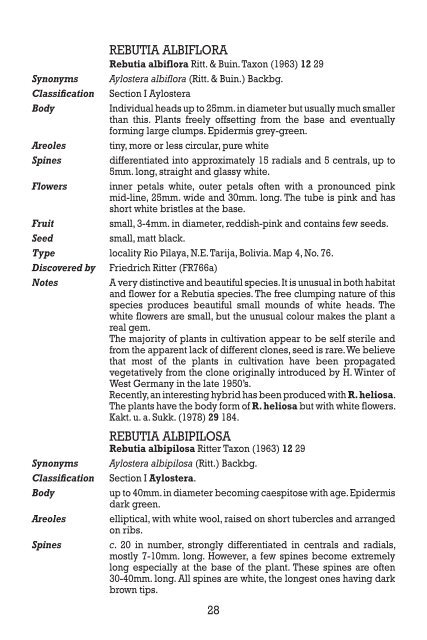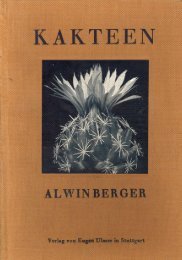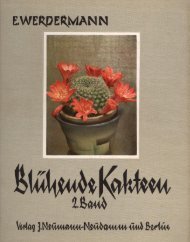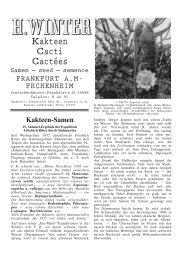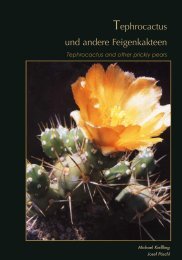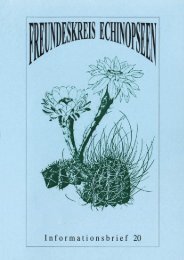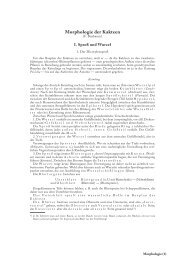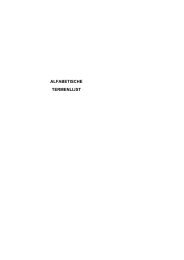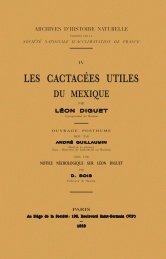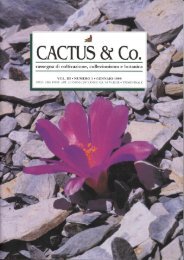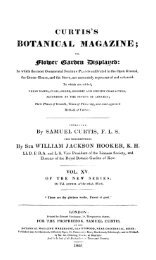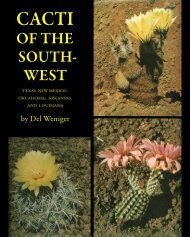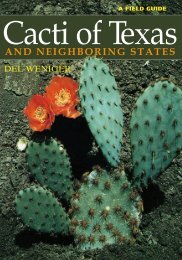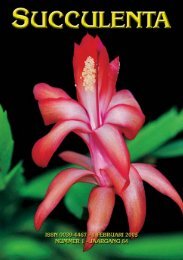the genus rebutia 1895—1981 - Free
the genus rebutia 1895—1981 - Free
the genus rebutia 1895—1981 - Free
You also want an ePaper? Increase the reach of your titles
YUMPU automatically turns print PDFs into web optimized ePapers that Google loves.
REBUTIA ALBIFLORA<br />
Rebutia albiflora Ritt. & Buin. Taxon (1963) 12 29<br />
Synonyms Aylostera albiflora (Ritt. & Buin.) Backbg.<br />
Classification Section I Aylostera<br />
Body Individual heads up to 25mm. in diameter but usually much smaller<br />
than this. Plants freely offsetting from <strong>the</strong> base and eventually<br />
forming large clumps. Epidermis grey-green.<br />
Areoles tiny, more or less circular, pure white<br />
Spines differentiated into approximately 15 radials and 5 centrals, up to<br />
5mm. long, straight and glassy white.<br />
Flowers inner petals white, outer petals often with a pronounced pink<br />
mid-line, 25mm. wide and 30mm. long. The tube is pink and has<br />
short white bristles at <strong>the</strong> base.<br />
Fruit small, 3-4mm. in diameter, reddish-pink and contains few seeds.<br />
Seed small, matt black.<br />
Type locality Rio Pilaya, N.E. Tarija, Bolivia. Map 4, No. 76.<br />
Discovered by Friedrich Ritter (FR766a)<br />
Notes A very distinctive and beautiful species. It is unusual in both habitat<br />
and flower for a Rebutia species. The free clumping nature of this<br />
species produces beautiful small mounds of white heads. The<br />
white flowers are small, but <strong>the</strong> unusual colour makes <strong>the</strong> plant a<br />
real gem.<br />
The majority of plants in cultivation appear to be self sterile and<br />
from <strong>the</strong> apparent lack of different clones, seed is rare. We believe<br />
that most of <strong>the</strong> plants in cultivation have been propagated<br />
vegetatively from <strong>the</strong> clone originally introduced by H. Winter of<br />
West Germany in <strong>the</strong> late 1950’s.<br />
Recently, an interesting hybrid has been produced with R. heliosa.<br />
The plants have <strong>the</strong> body form of R. heliosa but with white flowers.<br />
Kakt. u. a. Sukk. (1978) 29 184.<br />
REBUTIA ALBIPILOSA<br />
Rebutia albipilosa Ritter Taxon (1963) 12 29<br />
Synonyms Aylostera albipilosa (Ritt.) Backbg.<br />
Classification Section I Aylostera.<br />
Body up to 40mm. in diameter becoming caespitose with age. Epidermis<br />
dark green.<br />
Areoles elliptical, with white wool, raised on short tubercles and arranged<br />
on ribs.<br />
Spines c. 20 in number, strongly differentiated in centrals and radials,<br />
mostly 7-10mm. long. However, a few spines become extremely<br />
long especially at <strong>the</strong> base of <strong>the</strong> plant. These spines are often<br />
30-40mm. long. All spines are white, <strong>the</strong> longest ones having dark<br />
brown tips.<br />
28


